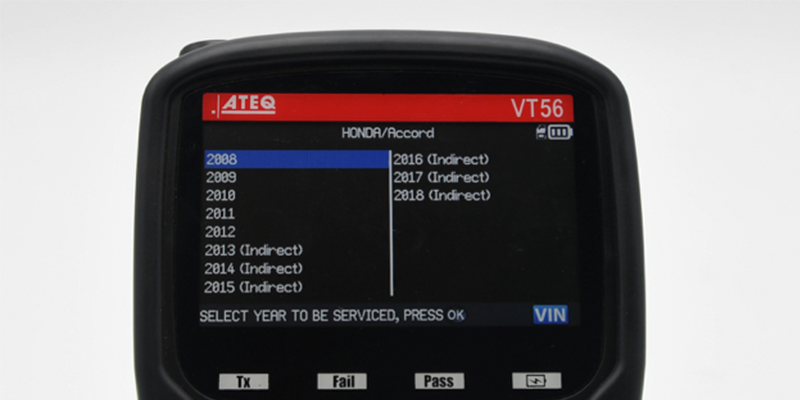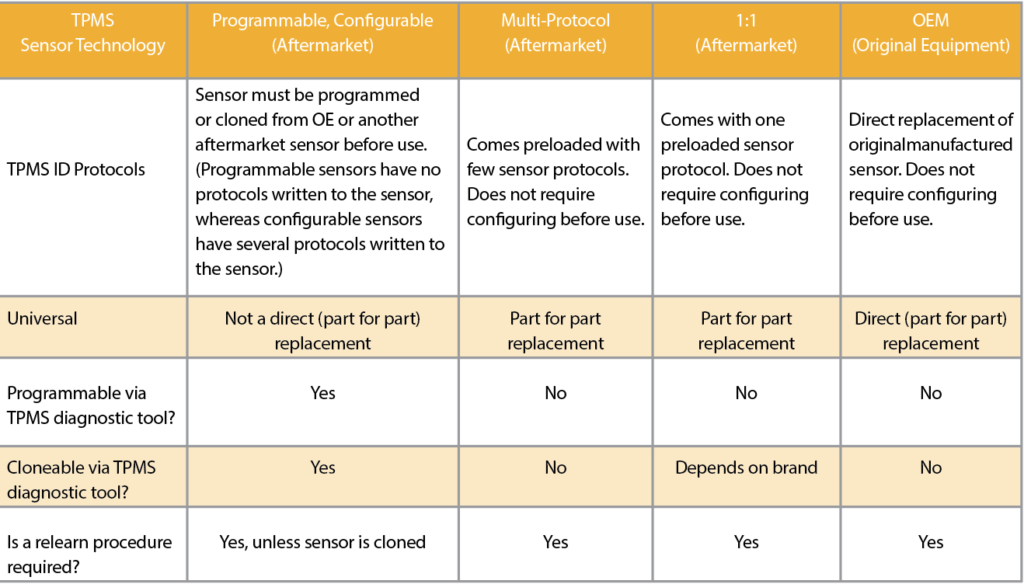There are two main categories when replacing a TPMS sensor: OEM and aftermarket. The automotive aftermarket provides technicians with many options when replacing a TPMS sensor, and with so many sensor options out there, it’s important to determine which one would work best for your shop.
Before determining which replacement TPMS sensors are right for your shop, be sure to invest in a TPMS scan tool that can aid in determining the TPMS sensor brands that should be used for replacement. The vehicle coverage depends on the TPMS sensor technology, and most shops invest in more than one sensor brand. It is best to use a TPMS tool that has the ability to read, activate and reset TPMS systems, as well as program more than one type of TPMS sensor brand. With the help of a TPMS scan tool, technicians can stock up on the appropriate sensors by using the following three best practices for TPMS sensor replacement.
1. Determine the TPMS System
There are two types of TPMS systems: direct and indirect. Direct TPMS systems use TPMS sensors inside the wheel to report pressure data to the vehicle’s ECU in real time. The direct systems include Asian, domestic and European vehicles. An indirect TPMS system uses an ABS system to monitor the speed of the wheel in order to record tire pressure readings correctly. Indirect systems can include Asian and some European vehicles.
Although there are no TPMS sensors within the wheel for vehicles with an indirect system, a relearn procedure must be performed to turn the TPMS light off. Some TPMS scan tools can help determine whether the system is direct or indirect, and will walk the technician step-by-step on how to reset their vehicle.
2. Choose a TPMS Sensor Type
To work on any vehicle that comes in the shop for TPMS services, most shops carry more than one sensor brand for the best vehicle coverage. With so many different TPMS sensors in the aftermarket, technicians should know which options are out there to choose what is best for them.
Original Equipment (OEM)
OEM sensors are a direct replacement of original manufactured sensors. The IDs are already written to the sensor, therefore, it does not need to be configured before it is installed.
Programmable or Configurable (Aftermarket)
Programmable or configurable sensors are aftermarket universal TPMS sensors. The sensor must be programmed or cloned from an OEM or another aftermarket sensor before use, using a TPMS tool.
Examples: Alligator Sens.it, Standard Qwik, NAPA Qwik, Schrader EZ-sensor, Orange Universal, MAX T.O.T.A.L., Mobiletron, PDQ, Steelman Select, U-Pro, Myers U-Pro, HUF Intellisens, and Dynamic Pro-Select.
Multi-protocol (Aftermarket)
Multi-protocol TPMS sensors are aftermarket sensors pre-loaded with few sensor protocols. It is a part-for-part replacement. Since the IDs are already written to the sensor, it does not need to be configured before use.
Example: VDO REDI-Sensor.
1:1 (Aftermarket)
One-to-one TPMS sensors are aftermarket sensors that are a direct replacement of an OE sensor with one preloaded sensor protocol. The IDs are written to the sensor and it does not need to be configured before use.
Examples: Dill OE, Standard OE, NAPA OE-Design, and Orange Direct Fit.
3. Choose the Correct TPMS Sensor Frequency
TPMS sensors are available in two frequencies: 315MHz and 433MHz. TPMS signals transmit at 433MHz in Europe and at 315MHz in most parts of the world. When replacing a TPMS sensor, be sure to verify it has the correct frequency for the vehicle system. Using the wrong frequency will result in a failed relearn procedure and/or failed sensor programming. A TPMS scan tool has the ability to determine the frequency of the old or new sensor.
There are a few simple ways to determine which sensor frequency a vehicle uses by using a TPMS scan tool.
- Read or activate the sensor, and the frequency information will be displayed on the tool.
- Use the “program sensor” function to determine which sensor frequency should be used when replacing the sensor, determined by the vehicle’s make, model and year.
Verifying the frequency helps technicians determine which brands of sensors to invest in for the future. Some TPMS models and model years from the same automaker use different frequencies. For example, a 2013 Nissan Rogue uses 315MHz sensors, and a 2014 Nissan Rogue uses 433MHz sensors. Once it is determined which frequency is used, your scan tool will display which brand of sensors has coverage for the vehicle by make, model and year.















